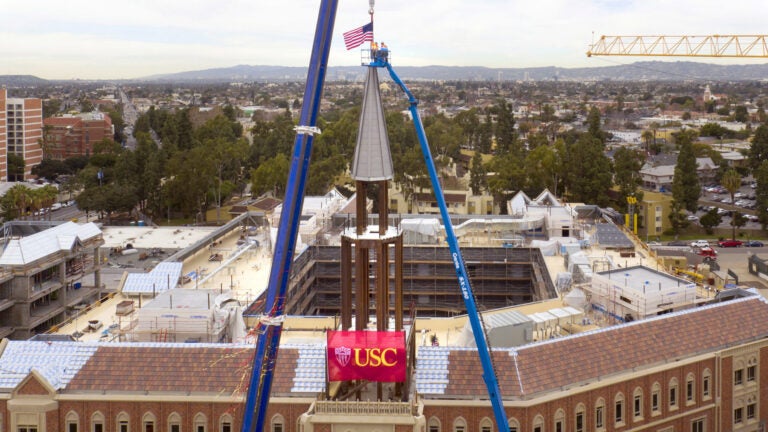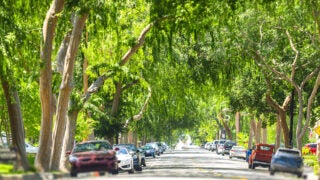
Cranes lift into position the spire during the topping ceremony marking the halfway point of USC Village construction. (USC Photo/Russell Houghten)
USC Village tops off with placing of landmark spire
It marks the halfway point in construction of the $700 million residential-retail project, on track to open in fall 2017
It’s not every day that construction workers get serenaded by a live band while a crowd of VIPs admires their work.
But that was the scene at the topping out ceremony for USC Village, the $700 million retail-residential complex being built on the former University Village site.
About 200 guests – including university officials and friends, local dignitaries and construction partners – joined the USC Village crews today to watch the raising of the ceremonial final beam as well as the eye-catching spire that is one of the project’s signature elements. But the day belonged to the construction workers who have worked tirelessly to keep the project on time and under budget.
“Today we pause to honor your tireless labor and pause to salute your selfless commitment,” USC President C. L. Max Nikias said. “We pause to say ‘thank you.’ ”
That’s what you are going to see first.
C. L. Max Nikias
Nikias said that when passengers are flying into LAX at night, the spire – which will be lit in the evening – will be a landmark. “That’s what you are going to see first,” he said.
The spire, which reaches 145 feet above ground, was raised to its home atop the Leavey Honors Hall as USC Trustee Kathleen Leavey McCarthy looked on. McCarthy, whose gift named the hall and the McCarthy Honors College it will house, was among those who signed the beam and spire before they were put in place.
Nikias noted that the university’s 136-year-old original building – Widney Hall, now the Widney Alumni House – was built in a month. But it didn’t have water or electricity.
USC Village has that and more, including 1.2 million square feet of space, more than a million feet of data cables and enough concrete to build a walkway from Los Angeles to San Francisco. What’s more, Nikias noted, with 2,700 students beds it will allow USC to become a fully residential university.
Businesses and jobs
Los Angeles City Councilman Curren Price and two-time USC graduate U.S. Rep. Karen Bass, in whose districts the project lies, spoke of their long support of the project, which will bring welcome businesses – and jobs – to the neighborhood, including the first Trader Joe’s market in south Los Angeles.
Lloyd Silberstein, USC vice president and executive director for capital construction and facilities management services, noted that the site was an empty lot just 15 months ago. Now it contains six buildings that are halfway toward completion.
“That’s an amazing accomplishment by what is clearly the best team of construction workers in the city of L.A.,” Silberstein said.
Growing campuses
The project is part of the most ambitious construction effort in USC history. When USC Village is finished in fall of 2017, the university will have added 3.5 million square feet of new and renovated space, increasing the size of the University Park and Health Sciences campuses by 30 percent each.
The work is a part of the Campaign for USC, a multiyear effort that seeks to raise $6 billion or more in private philanthropy to advance USC’s academic priorities and expand its positive impact on the community and world. Four years after its launch, the campaign has raised more than nearly $4.8 billion.



